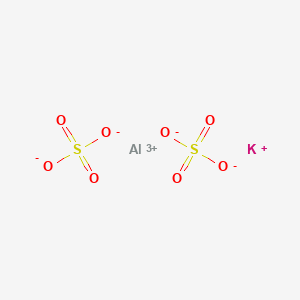



1. Alum
2. Alum, Potassium
3. Aluminium Potassium Sulfate 12-hydrate
4. Aluminium Potassium Sulfate Hydrate (1:1:2:12)
5. Aluminum Hydrogen Sulfate
6. Aluminum Potassium Disulfate Dodecahydrate
7. Aluminum Potassium Sulfate Dodecahydrate
8. Aluminum Sulfate
9. Potassium Alum
10. Potassium Aluminum Sulfate
1. Potassium Alum
2. 10043-67-1
3. Potash Alum
4. Potassium Aluminium Sulfate
5. Burnt Potassium Alum
6. Burnt Alum
7. Aluminum Potassium Disulfate
8. Aluminum Potassium Alum
9. Potassium Aluminum Sulfate
10. Aluminium Potassium Bis(sulphate)
11. Potassium Aluminum Alum
12. Alum, Potassium Anhydrous
13. Aluminium Potassium Sulfate
14. Aluminum Potassium Sulfate, Anhydrous
15. Sulfuric Acid, Aluminum Potassium Salt (2:1:1)
16. Aluminum;potassium;disulfate
17. Potassium Aluminum Disulfate
18. 09oxb01f3o
19. Alum Potassium
20. Aluminum Potassium Sulfate Anhydrous
21. Exsiccated Alum
22. 15007-61-1
23. Tai-ace K 20
24. Tai-ace K 150
25. Dialuminum Dipotassium Sulfate
26. Ccris 6842
27. Aluminum Potassium Sulfate, Alum
28. Hsdb 2685
29. Potassium Alum Anhydrous
30. Alum, N.f.
31. Einecs 233-141-3
32. Potassium Aluminum Sulfate (1:1:2)
33. Unii-09oxb01f3o
34. Aluminum Potassium Sulfate (alk(so4)2)
35. Aluminum Potassium Sulfate (kal(so4)2)
36. Aluminium Potassium Sulfate (1/1/2)
37. Potassium-alum
38. Potash-alum
39. Aluminum Sulfate-22%
40. Potassium-alum-
41. Aluminum Sulfate N-hydrate
42. Potassium Aluminum Sulphate
43. Ec 233-141-3
44. Alk(so4)2
45. Sulfuric Acid, Aluminium Potassium Salt (2:1:1)
46. Aluminumpotassiumsulfate
47. Burnt Alum (anhydrous)
48. Ins No.522
49. Alum, Potassium [hsdb]
50. Aluminum Sulfate N-hydrate Acs
51. Aluminum(iii) Potassium Sulfate
52. Dtxsid9039234
53. Chebi:86463
54. Ins-522
55. Aluminum Potassium Sulphate
56. Mfcd00003428
57. Akos015856586
58. Aluminum Potassium Sulfate [mi]
59. Db09087
60. Aluminum Potassium Sulfate [fcc]
61. Aluminum Potassium Sulfate [vandf]
62. Aluminium Potassium Sulfate Anhydrous
63. Aluminum Potassium Sulphate Anhydrous
64. Aluminium Potassium Sulfate [who-dd]
65. Aluminium Potassium Sulfate, Pure, Anhydrous
66. Aluminum Potassium Sulfate (1:1:2)
67. E-522
68. Ft-0622226
69. Ft-0626636
70. Aluminium Potassium Sulfate (1:1:2)
71. Aluminum Potassium Sulphate (1:1:2)
72. Aluminium Potassium-sulfate Dodecahydrate
73. Q411309
74. Sulfuric Acid, Aluminumpotassium Salt (8ci,9ci)
75. Aluminum Potassium Sulfate, Puriss., Anhydrous, Calcined, >=98% (calc With Ref. To Anhyd. Subst.), Powder
| Molecular Weight | 258.21 g/mol |
|---|---|
| Molecular Formula | AlKO8S2 |
| Hydrogen Bond Donor Count | 0 |
| Hydrogen Bond Acceptor Count | 8 |
| Rotatable Bond Count | 0 |
| Exact Mass | 257.8487042 g/mol |
| Monoisotopic Mass | 257.8487042 g/mol |
| Topological Polar Surface Area | 177 Ų |
| Heavy Atom Count | 12 |
| Formal Charge | 0 |
| Complexity | 62.2 |
| Isotope Atom Count | 0 |
| Defined Atom Stereocenter Count | 0 |
| Undefined Atom Stereocenter Count | 0 |
| Defined Bond Stereocenter Count | 0 |
| Undefined Bond Stereocenter Count | 0 |
| Covalently Bonded Unit Count | 4 |
Potassium alum is considered safe by the FDA and its use is in homepathic or OTC products. Due to its presence in several different drugs, the main indications for the use of potassium alum are: -Constipation -Cosmetic or drug astringent, helping the shrinkage of tissues and the dry of secretions -Oral health care drug -Part of formulation in cleansing products, skin-care products, mosturizers, face powders and deodorants -Antiperspirant -Antifungal
The presence of potassium alum reduces swollen mucous membranes that result from inflammation of the nasal, gastrointestinal and urinary passages as well as in the presence of excessive secretions. The induction of the coagulation cascade will also stop bleeding.
Adjuvants, Immunologic
Substances that augment, stimulate, activate, potentiate, or modulate the immune response at either the cellular or humoral level. The classical agents (Freund's adjuvant, BCG, Corynebacterium parvum, et al.) contain bacterial antigens. Some are endogenous (e.g., histamine, interferon, transfer factor, tuftsin, interleukin-1). Their mode of action is either non-specific, resulting in increased immune responsiveness to a wide variety of antigens, or antigen-specific, i.e., affecting a restricted type of immune response to a narrow group of antigens. The therapeutic efficacy of many biological response modifiers is related to their antigen-specific immunoadjuvanticity. (See all compounds classified as Adjuvants, Immunologic.)
Absorption
Potassium alum is found in its dodecahydrate form that produces a very large molecule. This large molecule cannot be absorbed through the skin when this substance is included as an astringent agent in topical OTC. If ingested, the aluminum salts are rapidly solubilized in the stomach and then they can generate aluminum hydroxide or poorly absorbed basic aluminum salts.
Route of Elimination
When potassium alum is absorbed, the kidney is responsible for the elimination of the major portion of the absorbed dose. From the excretion, 0.1-0.3% of the absorbed dose is eliminated via the urine.
Volume of Distribution
The distribution of aluminum salts in the body is influenced by increased concentrations of parathyroid hormone. It was shown, in preclinical studies, that oral administration of aluminum salts produces a distribution profile that forms deposits in kidneys, muscle, bone and gray matter.
Clearance
Renal clearance of aluminum is approximately 5-10% of the excretion of urea or creatinine. The reduced clearance of aluminum compounds is due to the high protein binding.
Potassium alum does not go through a metabolic pathway. When ingested or absorbed, it will get rapidly dissolved and it will form ions that will later generate other salt derivatives.
Studies performed with aluminum compounds have shown a half-life of 4.5 h when administered intravenously.
The main functions of potassium alum in drugs are as an astringent, antiseptic or adjuvant agent. The astringent action is performed by the induction of coagulation in the superficial tissue layers until the formation of a crust. The formation of alum ions neutralize the charges on plasma proteins, causing the blood to coagulate. Similar effect is observed in disinfectants where these ions react with the free organic acid and thiol groups of proteins on microbes and free proteins, resulting in protein precipitation. This action will generate the contraction of the tissue and dry up secretions. Its adjuvant properties are mainly used in the production of vaccines where the presence of this chemical enhances the immune response.
